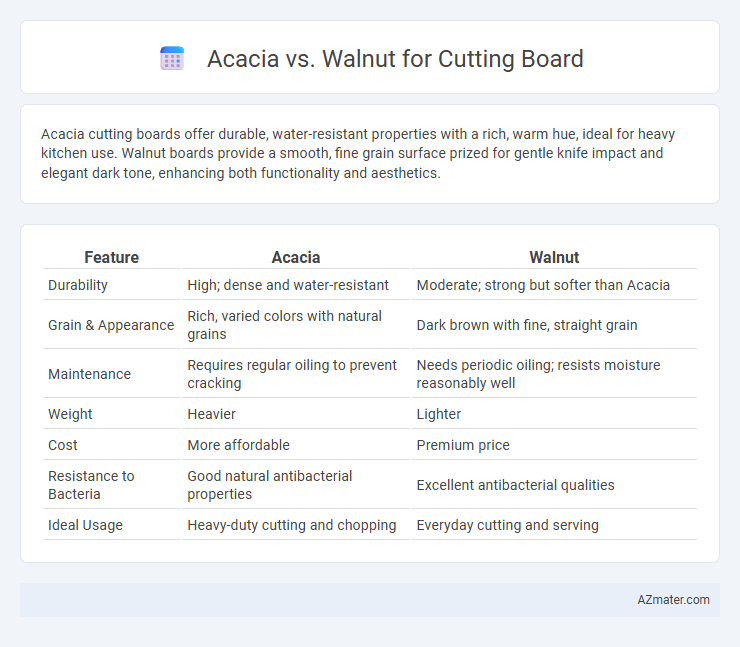Acacia cutting boards offer durable, water-resistant properties with a rich, warm hue, ideal for heavy kitchen use. Walnut boards provide a smooth, fine grain surface prized for gentle knife impact and elegant dark tone, enhancing both functionality and aesthetics.
Table of Comparison
| Feature | Acacia | Walnut |
|---|---|---|
| Durability | High; dense and water-resistant | Moderate; strong but softer than Acacia |
| Grain & Appearance | Rich, varied colors with natural grains | Dark brown with fine, straight grain |
| Maintenance | Requires regular oiling to prevent cracking | Needs periodic oiling; resists moisture reasonably well |
| Weight | Heavier | Lighter |
| Cost | More affordable | Premium price |
| Resistance to Bacteria | Good natural antibacterial properties | Excellent antibacterial qualities |
| Ideal Usage | Heavy-duty cutting and chopping | Everyday cutting and serving |
Introduction to Acacia and Walnut Cutting Boards
Acacia cutting boards are prized for their rich, warm tones and natural water resistance, making them a durable choice for kitchen use. Walnut cutting boards are known for their deep, dark brown color and fine grain, offering a sturdy and elegant surface ideal for both cutting and serving. Both woods provide strong antibacterial properties, making them hygienic options for food preparation.
Key Differences Between Acacia and Walnut Wood
Acacia wood is known for its high density, durability, and natural resistance to water and bacteria, making it an excellent choice for cutting boards in humid or heavy-use environments. Walnut wood offers a rich, dark color with a smooth texture that is less porous, reducing knife wear and providing a more refined look, but it tends to be softer than Acacia, requiring more frequent maintenance. The key differences lie in Acacia's superior hardness and moisture resistance versus Walnut's aesthetic appeal and gentler surface for knives.
Durability and Hardness Comparison
Acacia wood is known for its high density and hardness, typically ranging from 2350 to 3000 on the Janka hardness scale, making it durable and resistant to knife marks and dents. Walnut, with a Janka hardness around 1010, is softer but offers good durability while being more gentle on knife edges. For cutting boards, acacia provides superior resistance to wear and tear, whereas walnut balances durability with a softer surface that reduces blade dulling.
Grain Pattern and Visual Appeal
Acacia cutting boards feature a striking, irregular grain pattern with rich, warm tones ranging from golden to deep brown, creating a visually dynamic surface. Walnut offers a smoother, tighter grain with a consistent dark chocolate hue that exudes elegance and sophistication. Both woods provide unique visual appeal, with Acacia's bold pattern enhancing rustic kitchens while Walnut's refined appearance suits modern and upscale settings.
Maintenance and Care Requirements
Acacia cutting boards require moderate maintenance, benefiting from regular oiling with mineral oil to prevent cracking and preserve their natural moisture resistance. Walnut cutting boards demand consistent care with frequent oiling and occasional conditioning with beeswax to maintain their rich color and prevent drying out. Both woods should be hand-washed promptly and dried thoroughly to avoid warping and extend the lifespan of the cutting board.
Knife Friendliness: Acacia vs Walnut
Acacia and walnut are popular cutting board materials known for their knife-friendly properties, but walnut is often preferred due to its softer, tight-grained surface that minimizes blade dulling over time. Acacia is harder and denser, providing durability but potentially causing slightly more wear on knives compared to walnut. Both woods maintain a good balance between hardness and resilience, making them excellent choices for preserving sharp edges during regular kitchen use.
Sustainability and Environmental Impact
Acacia cutting boards are considered more sustainable due to the tree's fast growth rate and its ability to thrive in dry, arid regions, which reduces deforestation pressure on hardwood forests. Walnut, while durable and prized for its rich color, grows slower and is often sourced from old-growth forests, raising concerns about habitat loss and less sustainable harvesting practices. Choosing acacia supports eco-friendly production with lower environmental impact and promotes renewable resource use in kitchenware.
Price and Availability
Acacia cutting boards are generally more affordable than walnut, making them a budget-friendly option for many households. Acacia wood is widely available due to its fast growth rate and abundant supply, resulting in steady pricing and ease of purchase. Walnut cutting boards tend to be pricier and less readily available because of slower tree growth and higher demand in premium kitchenware markets.
Pros and Cons of Acacia Cutting Boards
Acacia cutting boards offer exceptional durability and resistance to water due to their dense hardwood composition, making them ideal for heavy-duty kitchen use and preventing warping over time. Their natural antimicrobial properties and rich, warm color add aesthetic appeal, but they require regular oiling to maintain their surface and avoid drying out or cracking. Compared to walnut, acacia boards are generally more affordable yet slightly less resistant to knife marks, necessitating careful maintenance to preserve their smooth cutting surface.
Pros and Cons of Walnut Cutting Boards
Walnut cutting boards are prized for their durability, rich dark hue, and natural resistance to bacteria, making them a hygienic and stylish choice in kitchenware. Their fine grain and hardness provide a smooth cutting surface that is gentle on knife edges, but they tend to be more expensive and may show scratches and knife marks more visibly compared to lighter woods. Walnut requires regular oiling to maintain moisture balance and prevent drying or cracking, which adds to maintenance but also extends the board's lifespan.

Infographic: Acacia vs Walnut for Cutting Board
 azmater.com
azmater.com